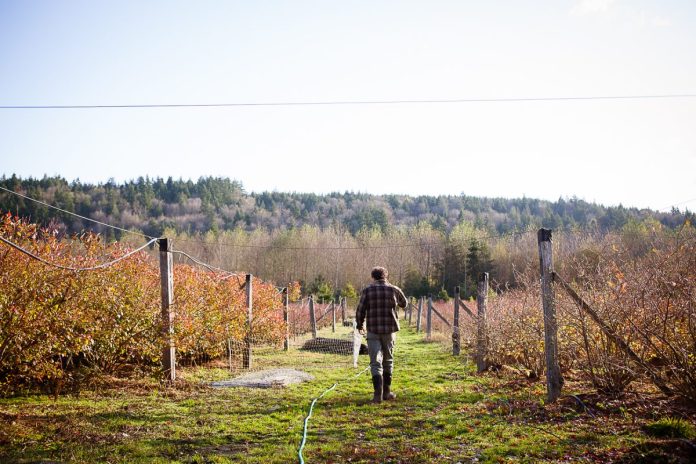On Tuesday, July 21st, Futurewise hosted Addie Candib, Pacific Northwest Regional Director of American Farmland Trust for a conversation about the threatened state of farmland in Washington. You can watch our entire conversation on the Futurewise Facebook page.
Before we dig into our conversation with Candib, let’s start with an honest understanding of the history of farming in America.
Stolen Labor, Stolen Land
In the American South, enslaved Africans and their descendants toiled under brutal conditions to enrich White enslavers. Formerly enslaved people were promised “40 acres and mule” by General William Sherman, only to see President Andrew Johnson renege in 1865. By 1870, only around 30,000 African Americans in the South owned land, compared with four million who did not.
Today, Black farmers account for just 1.4% of producers across the United States. Across the West, the mythology of Manifest Destiny and the Homestead Act of 1862 promised households 160 acres of land in exchange for working the land for at least five years, land that was forcibly taken by the United States government from indigenous nations. During World War II, Japanese American farmers were forced to sell their farms far below market rates before being forced into internment camps. Today, despite the fact that 83% of all farmworkers are Hispanic, producers who identified as Hispanic, Latino or Spanish origin account for just 3.3% of US producers.
These are just a few examples of vast racial disparities in who has access to farm ownership and production and it’s critical we understand this history when we talk about how to protect Washington farmland and invest in the next generation of farmers.
Protecting Our Most Valuable Farmland
The Farms Under Threat: State of the States report from the American Farmland Trust (AFT) provides an interactive map, along with policy analysis, about the declining state of farmland in the United States. Across the United States, between 2001 and 2016, 11 million acres of farmland and ranchland were converted to urban and highly developed land use (4.1 million acres) or low-density residential land use (nearly 7 million acres). That’s equal to 2,000 acres a day paved over, built up, and converted to uses that threaten the future of agriculture.
Fortunately, Washington ranks in the top twelve in policy response to changes in agricultural lands and ranks second only to Oregon when it comes to land use planning, thanks to the Growth Management Act. Washington has lost 98,000 acres of agricultural land between 2001 and 2016, compared to over 500,000 of acreage lost in states like North Carolina, Georgia and Tennessee.
A quick note about how to prioritize farmland for protection: all farmland is important to state and local economies and to the food system. That said, resources for protecting farmland are limited. The American Farmland Trust advocates that states prioritize protecting “Nationally Significant” land, or land which is most critical for long-term food security and environmental quality. The conversion of “nationally significant” land puts the pressure on more marginal lands to produce food, which can in turn mean higher inputs and lower production, as well as increased soil erosion and water quality degradation.
There is a real economic and environmental cost to converting our most productive, versatile, and resilient (PVR) land. But it’s also important to recognize that there are other reasons that farmland might be protected other than its ability to grow food. A community might prioritize protecting a parcel of more “marginal” farmland because it has important wildlife or cultural benefits.
Investing in the Next Generation of Washington Farmers
The Farms Under Threat report dives into many different pressures facing farmers but in this column we’re going to focus specifically on the question of transferring land to new farmers. In Washington, farmers over the age of 65 outnumber farmers under 35 by a factor of 5:1. Fortunately, the American Farmland Trust and Futurewise have a few policy ideas to work from.
Farm linking or land linking programs connect land seekers to available land. “Land linking is time-intensive and staff intensive,” Candib said. “You have to meet land seekers where they’re at and meet landowners where they’re at.” In Washington, some local community groups have stepped up. In Thurston County, the South Sound FarmLink initiative connects “farmers and landowners to local resources, technical and financial assistance, and most importantly each other.” PCC Farmland Trust’s Farm to Farmer program does the same in Pierce, King and Skagit counties. Unfortunately though, Washington lacks a statewide land linking program.
Another popular tool is the use of conservation easements, in which a nonprofit or public agency purchase the development rights for a farm and add a permanent restriction on development and subdivision of the property. Landowners are paid a portion of the property value and retain other property rights. Easements have an advantage in that older farmers who are relying the sale of farmland for their retirement can make the needed profit on their land without selling to a property developer. On the downside, easements work only at the scale of individual properties and in very high land value regions, putting an easement on the property will still not reduce the price to be affordable to new farmers.
A Transfer of Development Rights (TDR) program takes individual conservation easements to the next level, by linking conservation with urban development. A TDR program basically creates a marketplace for development rights that transfers development capacity from rural areas to urban neighborhoods. Rural landowners sell the right to develop their land, in exchange for compensation and a conservation easement. Then urban developers can purchase those rights to increase the number of units or square footage on urban projects. While TDR programs are harder to implement at the outset, as they require buy-in from a broader range of stakeholders, there’s an advantage in taking a regional approach to growth.
As Alex Brennan, Futurewise Executive Director put it: “It’s easy to identify where we don’t want to see growth happen. It’s harder to identify where do we want to see growth.” TDR programs are an opportunity to build coalition across geographies. By growing and investing in our cities, we can protect our farmland, forest land and natural habitat.
Protecting Washington farmland for the long haul will likely require a whole suite of policy response, from continuing to flex our GMA authority to protect farmland in comprehensive plan updates, scaling up conservation easements and community land trusts and expanding TDR programs to more counties across Washington. To dig in more with Candib about development, agriculture, and the next generation of farmers, check out the full conversation.
King County Wineries, Breweries and Distilleries Ordinance Appeal Victory
Speaking of farmland protection, Futurewise recently secured a victory with the Growth Management Hearings Board regarding the King County wineries, breweries and distilleries ordinance (covered in our May 2019 Wonkabout column).
When the ordinance was first being considered, Futurewise raised concerns about the impact of expanded tasting rooms on farms in the Sammammish Valley, including “potential negative direct and indirect impacts on working farms including increased purchases of land by speculators at prices farmers cannot afford, the conversion of agricultural land to non-agricultural uses and stormwater runoff impacts on fields and farms.”
On March 26, 2020, the Growth Management Hearings Board (Board) granted Futurewise’s and the Friends of the Sammamish Valley’s dispositive motion, agreeing that the King County Wineries, Breweries, and Distilleries Ordinance violated the Washington State Environmental Policy Act (SEPA).
The board granted the motion because King County did not review the environmental impacts of the ordinance early enough in the process. This is important because local governments and state agencies benefit from considering the potential adverse impacts of their decisions early to tailor their decisions to lessen adverse environmental impacts such as water pollution. The board also concluded that the environmental document the County prepared, called a SEPA Checklist, did not disclose the potential adverse impacts of the ordinance including adverse impacts on ground water quality, working farms, and increased demand for water in near streams that already have flows too low to sustain the salmon runs on which fishers and the Southern Resident Orcas depend. The board directed the County to take another look at the impacts of the ordinance by November 6, 2020.
The board also concluded that the potential adverse impacts of the Wineries, Breweries, and Distilleries Ordinance, such as its potential impacts on rural character, water quality, working farms, and water availability substantially interfered with the goals of the Growth Management Act. Therefore, the Board concluded that new permit applications cannot be approved using the ordinance. This will prevent adverse impacts on rural areas and agricultural lands while the County conducts a new review of the environmental impacts.
Correction: An earlier version incorrectly identified President Andrew Johnson as Andrew Jackson. Wrong Andrew.
Futurewise works throughout Washington State to encourage healthy, equitable, and opportunity-rich communities and to protect our most valuable farmlands, forests and water resources through wise land use policies and practices. Founded to help support implementation of the first-in-the-nation Growth Management Act, we focus on directing equitable growth into our urbanized areas and preventing the conversion of wildlife habitat, open space, farmland, and working forests to subdivisions and development.



